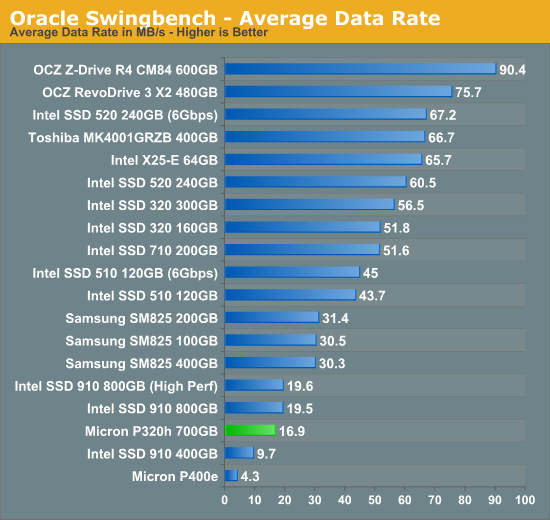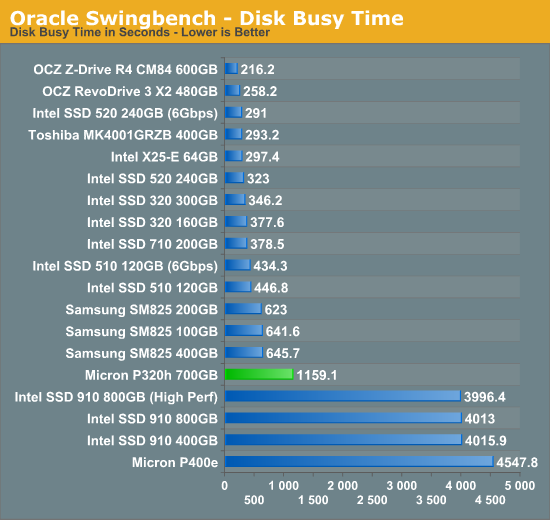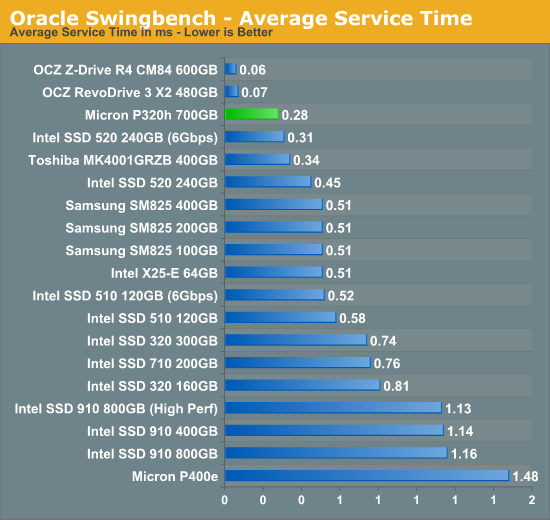Micron P320h PCIe SSD (700GB) Review
by Anand Lal Shimpi on October 15, 2012 3:00 AM ESTEnterprise Storage Bench - Oracle Swingbench
We begin with a popular benchmark from our server reviews: the Oracle Swingbench. This is a pretty typical OLTP workload that focuses on servers with a light to medium workload of 100 - 150 concurrent users. The database size is fairly small at 10GB, however the workload is absolutely brutal.
Swingbench consists of over 1.28 million read IOs and 3.55 million writes. The read/write GB ratio is nearly 1:1 (bigger reads than writes). Parallelism in this workload comes through aggregating IOs as 88% of the operations in this benchmark are 8KB or smaller. This test is actually something we use in our CPU reviews so its queue depth averages only 1.33. We will be following up with a version that features a much higher queue depth in the future.

Intel's SSD 910 didn't do well at all in our Oracle Swingbench test, mostly due to its inability to perform well at very small transfer sizes (512B). The P320h is no different here and is easily outperformed by standard 2.5" SATA SSDs (although Micron's P400e also does really poorly here). The results here just go to show how important it is that you understand your workload when picking an enterprise SSD.
Average service time is nice and low for the P320h, it's just we don't end up seeing a high throughput rate for the SSD.












57 Comments
View All Comments
speculatrix - Tuesday, October 16, 2012 - link
flash memory comes in different forms and longevities.the best SLC flash will outperform and outlast the cheapest TLC flash by considerable margins, but at a cost.
car analogy: do you want a performance car which is extremely well built and designed to survive in harsh environments, or a cheap family car which can only survive a Californian "winter"?
milkod2001 - Monday, October 15, 2012 - link
They have to make this thing bootable and sell 120GB version for 300 bucks max, until then this is just like reading about NASA's new spaceship(interesting but no use for 99% of users)kevith - Monday, October 15, 2012 - link
Spot on!A5 - Monday, October 15, 2012 - link
If you only care about consumer-ready cheap stuff, there are plenty of really boring tech sites out there for you to read.ender8282 - Monday, October 15, 2012 - link
I was just talking with a co-worker a little while ago about how a device like this would give us more head room. It is extremely relevant to our workload, and I'm glad to see this article. Just because it isn't for home use you shouldn't ignore it. If this technology works (and works well) in the enterprise market, it will likely eventually trickle down to the consumer market. Would have liked to see prices, but if this is comparable to a high end raid controller, plus a bunch of fast SSDs it will likely be an option for lots of people.taltamir - Monday, October 15, 2012 - link
This is not for home users, its for enterprises with a lot of money and extreme speed needs.mattlach - Tuesday, October 16, 2012 - link
It's not intended for you, or me, or any other consumers.This is a enterprise server part, and for that market its probably priced about right.
I would LOVE to see a bootable native PCIe consumer drive with MLC NAND priced more reasonably for the consumer market, and we likely will in the not TOO distant future, but they aren't here yet.
zlyles - Tuesday, October 16, 2012 - link
What you fail to realize is these SSD's (Micron P320h, Intel 910 and OCZ Z-Drive) are targeted at enterprise markets. The majority of these enterprise customers would purchase these drives as high IOPS storage or for running virtual servers/desktops from. Most of these companies are likely using a virtualized solution(VMware ESXi) in which case the hypervisor is loaded into ram at boot anyway, not much point in booting the OS from SSD.If you are looking for a solution for 99% of users, I'm not really sure why you are even looking at PCI-e SSD's, there is a VERY small market for PCI-e SSD's(bootable or not) on the consumer side.
JellyRoll - Monday, October 15, 2012 - link
Man! For the tens of thousands of dollars that customers would spend on one of these SSDs there is no way in the world that anyone would ever run one under 128QD, ever.These are designed to be run 100% full bore, not at QD 1. These benchmarks are totally irrelevant, and have no real meaning. This is like testing an Nascar vehicle in a small parking lot.
Sivar - Monday, October 15, 2012 - link
You're right, who in their right mind would run all these irrelevant real-world database tests to see actual performance in the target market?I'm sure you're speaking from a lot of industry experience. I'm also sure you've ever seen a sustained queue depth of 128 on any real-world system.